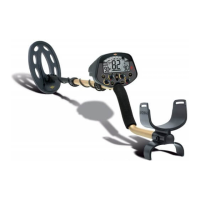SEARCH TECHNIQUES (continued)
Tips on ground balancing
When the F75 first turns on, the ground balance setting is preset to 90. This will give a
positive response on nearly all soils. If you search in the Discrimination mode, you will
probably not have to balance to the ground. If you switch to All Metal mode, ground
balancing will probably be necessary.
You must find a spot of ground which is free of metal to accurately balance to the ground.
Before you attempt to Ground Balance, sweep back and forth to see if any metal target is
present. Locate what seems to be a clear area and then Ground Balance. Ground
Balancing may be done automatically by pushing the trigger, or manually if you are in All
Metal mode. After you have ground balanced, sweep back and forth to see if there is little
or no audible response to the soil. This is best done either in All Metal mode, or in
Discrimination mode with discrimination set to zero. Alternatively, use the PinPoint
trigger to check the spot. If there is little or no response, ground balancing was successful.
If there is still substantial response, there may have been metal present where you
attempted to ground balance, so find another promising spot and try again. If you cannot
find a spot to successfully ground balance, it is time to give up. Reset the ground setting to
90 and then use the machine without ground balancing.
In most areas, once you have ground balanced, the ground balance setting will remain
satisfactory for a long time. However, if the soil has been disturbed by digging or the
addition of fill dirt, or if you are in a geologically complex setting such as is commonly
encountered in gold prospecting areas, you may have to frequently perform the ground
balancing procedure to accommodate changing soil conditions.
When you ground balance, the numerical Ground Setting will momentarily appear on the
LCD screen. In general, sandy or gravelly soils will tend to read in the 75-95 range, light
colored loams and clays will tend to read in the 50-80 range, and red clays will tend to read
in the 35-55 range. To express it in other terms, the more highly weathered, oxidized, or
finely grained the soil is, the lower the numeric reading will be.
The Fe
3
O
4
bar graph indicates how much iron mineralization is present. For it to work, the
searchcoil must remain in motion. The most accurate readings will be achieved by
pumping the coil as you do when ground balancing. The higher the mineralization, the
greater the necessity to ground balance the detector for the best depth performance.
If you are searching for relics, you can make a map of the soil of the site. Make a grid of
the site. Then collect data. Ground Balance to document mineral type; view mineral
amount on the Fe
3
O
4
bar graph. Then plot the data on the site map and draw isolines. In
this way you may be able to locate areas which have been dug, backfilled, or subjected to
fire. This information in turn helps to reveal the history of the site.
